Plant Profiles dive deep on one plant variety each month. They are meant to provide you with enough information to make good growing decisions. A desire to grow gorgeous flowers is one thing. However, discerning if a particular plant is right for you and your climate is a whole other ballgame.
My intention here is to give you as much practical information to make these decisions. However, I’m going one step further and taking you completely behind the scenes to share exactly what has worked for us as well. For this reason, Plant Profiles are broken up into what I’m calling the “Nuts and Bolts (N&B)” and “Behind the Scenes (BTS).”
If you haven’t already, please be sure to read the FFY Introduction to learn more about how Plant Profiles are organized.
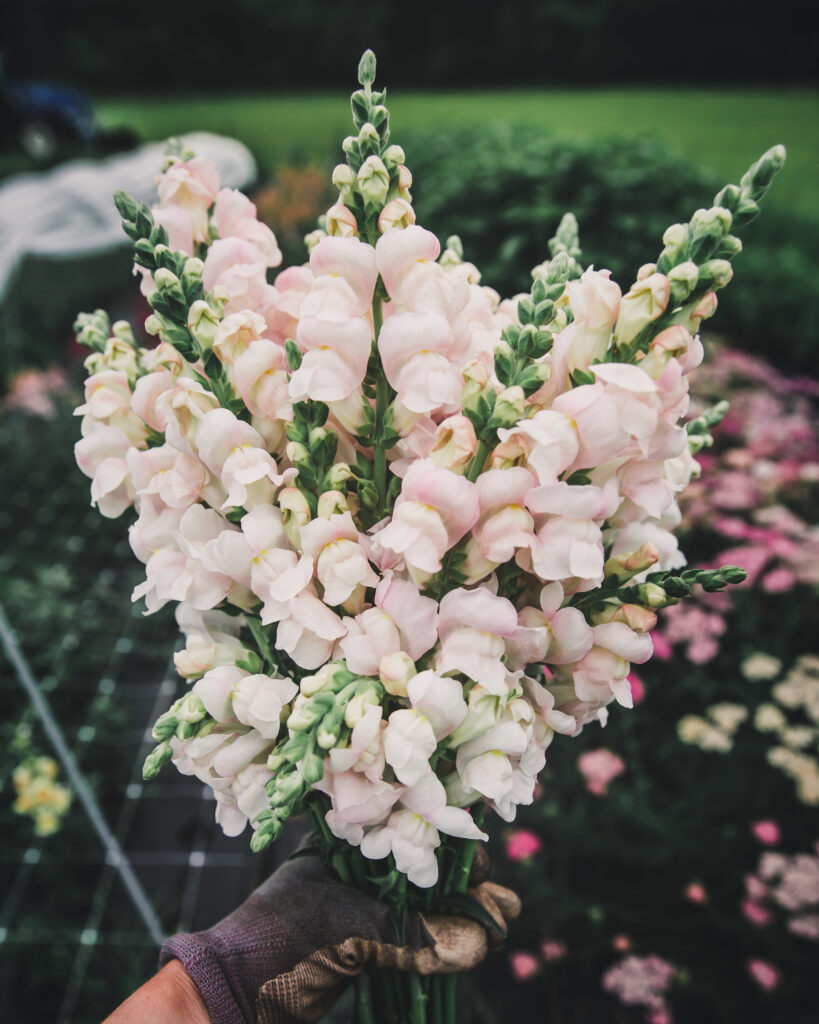
Primary Sources
The primary sources for the N&B portion come from:
- Postharvest Handling of Cut Flowers and Greens: A Practical Guide for Commercial Growers, Wholesalers & Retailers (Dole, Stamps, Carlson, et al).
- Specialty Cut Flowers, 2nd Edition, Revised & Enlarged (SCF): Industry standard for both new and experienced growers on the production of annuals, perennials, bulbs, and woody plants for fresh and dried cut flowers (Allan M. Amritage and Judy M. Laushman)
- Johnny’s Selected Seeds (Johnny’s): Johnny’s has been in the business for 50 years, with a research farm dedicated to finding the best seeds and tools for farmers and gardeners
- BOSTON Ornamental Terminal Prices. Specialty Crops Market News Federal – State Market News Service, USDA (as of 14-FEB-2023
- Farmer Bailey’s website: Bailey Hale is a past Regional Director of the ASCFG, seed-crop producer, plug broker, and a leading farmer-florist expert)
- Lisa Mason Ziegler’s Field & Flower Podcast with David Dowling, Episode 98: Lisa Mason Ziegler is a past Regional Director of the ASCFG, leading farmer-florist expert, author, podcast host, with a vast library of online workshops, while David Dowling is a past Director and President of the ASCFG, with over twenty years flower farming, eventually working for Ednie/Gloeckner
- Snapdragon Cut Flower Production in Utah. Utah State University. Lewis, Stock, Maughan, et. al.
- Improving Snapdragon Cut Flower Production through High Tunnel Season Extension, Transplant Timing, and Cultivar Selection, HortScience horts, 56(10), 1206-1212. Lewis, Stock, Maughan, et. al. Retrieved Apr 18, 2023, from https://doi.org/10.21273/HORTSCI15910-21
Zone Considerations
- Johnny’s Selected Seeds research farm is located in Zone 5a Maine
- Bailey Hale and Thomas McCurdy’s previous farm, Ardelia Farms, is located in Zone 4a Vermont
- Lisa Mason Ziegler’s farm, The Gardener’s Workshop, is located in Zone 7a/8b Virginia
- USU Trials were conducted at Greenville Farms, Zone 5 Utah and USU Botanical Center, Zone 6 Utah
- HortScience references farms Zones 3–8
- My farm, Petal Back Farm, is located in Zone 4b Wisconsin
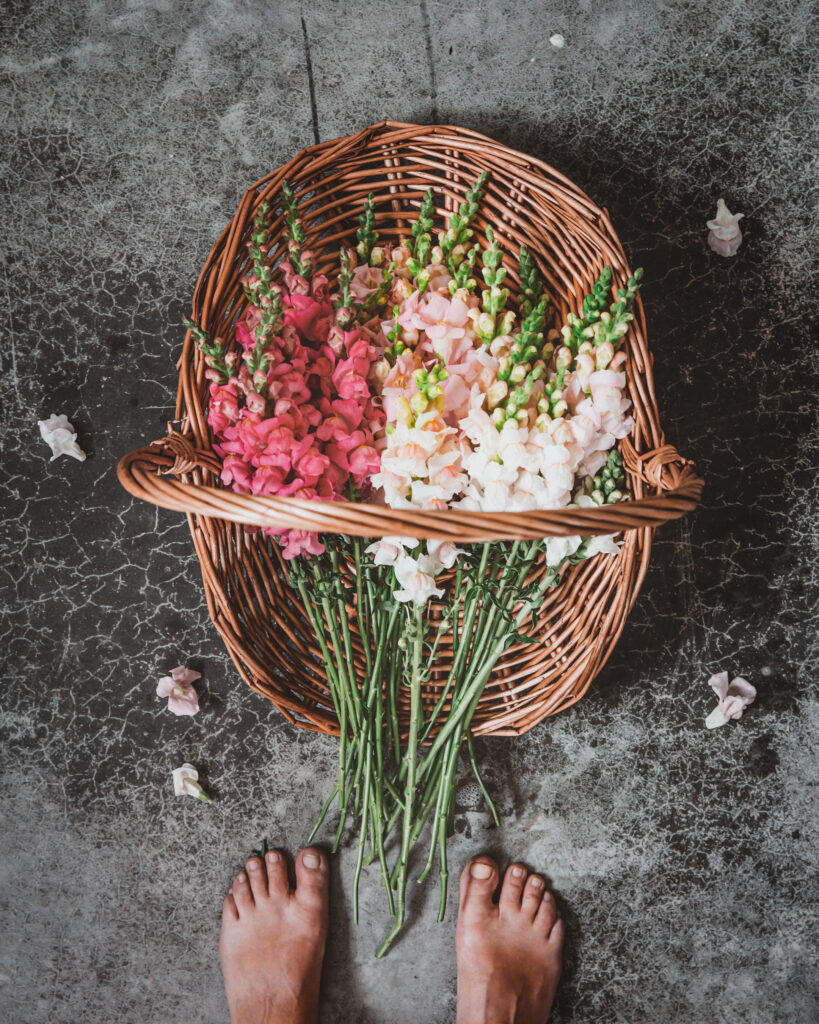
General Information: N&B
- Latin Name Name: Antirrhinum majus
- Common Name: Snapdragon
- Origin: Mediterranean
- Days to Maturity: 105–120 days (depending on variety)
- Life Cycle: Annual
- Spacing: 4–12″
- Height: 12-60″. When grown as a one-cut, stems can be as long as the full height of the plants. When grown for multiple cuts per plant, stems vary in length at 12-36″.
Snapdragons are native to northern temperate zones, with a focus in the Mediterranean region. The dense flower spikes bear tubular or butterfly-shaped blooms in an array of colors popular for use as cut flowers (Johnny’s). They are also edible! Snaps are grown as cool-season annuals in most areas. Greenhouse production is common in the United States. Snaps can be field produced in the spring in southern and far western states. They can be field produced in the summer in northern states (SCF).
Modern varieties have been bred for optimal performance under specific growing conditions and seasons. Most snapdragon varieties are classified into numbered groups corresponding with the growing and harvest periods for which they are bred (Johnny’s). There will always be a market for spike flowers and few can provide the color range as snapdragons (SCF).
General Information: BTS
I love, love, love snapdragons! I think this nostalgic flower is a must grow for the farmer florist because they are super reliable, bloom abundantly, and are popular among florists, wholesale, and retail customers. Bonus: Pollinators love them too and they have the sweetest, bubblegum scent.
What I love most about snaps as a cut flower:
- Easy to grow
- Good vase life
- Last long on the stem
- Amazing array of colors
- Great spike flower for design and bouquets
- Popular with florists, wholesale, and retail customers
- Nostalgic flower
- Soft, subtle scent
- Prolific
- Resilient
- Attract pollinators
- Edible flowers
- Can sell by the bunch
But every rose has its thorn, right? Potential shortcomings:
- Geotropic, meaning it’s sensitive to gravity and if support netting isn’t strong or stems not stored upright, stems will bend (and not in the “cool” design way, more like a 90-degree angle, ha).

Propagation: N&B
Snaps are typically grown from seed, though Gemma from Green Rabbit Flowers successfully propagates cuttings as a means of increasing stock. Pregrown plugs can also be purchased and Dowling notes that they are one of the lowest-cost plugs (as little as 12 cents per plant).
Johnny’s recommends sowing seeds in a 128-cell tray or preferred seedling container, 8–10 weeks before planting out after the last frost. Light is needed for germination, but a thin layer of fine vermiculite covering the seed will help maintain moisture levels and prevent algae growth. Bottom-water to avoid covering the seed with displaced soil. After emergence, reduce moisture levels and keep soil evenly moist but not saturated. Maintain a soil temperature of 65–75F (18–24C). After plants have 3–5 leaves, SCF recommends maintaining temperatures as close to 60F (15C) as possible to avoid lanky transplants. Harden off plants prior to transplanting.
Propagation: BTS
We grow all of our snaps from seed, sown in 128-cell trays. I do not bump them up, they go straight into the field at this size. I honestly don’t really worry about the temperature.
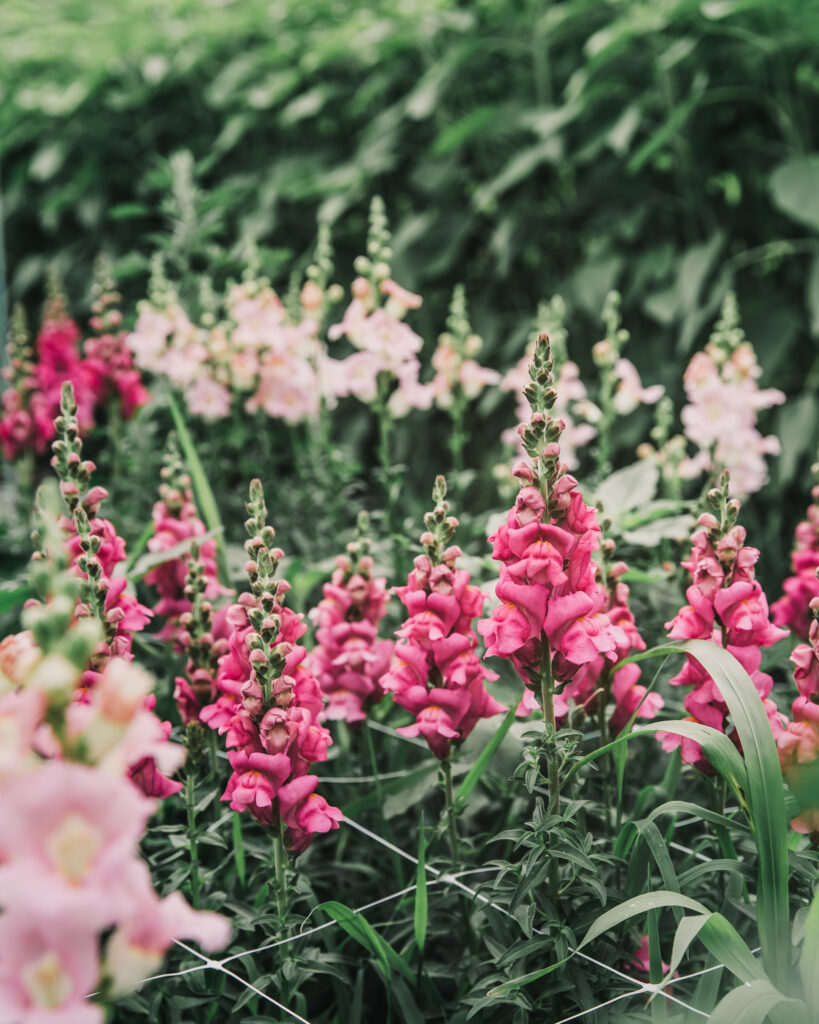
Environmental Factors: N&B
Photoperiod
Many current greenhouse varieties have been bred to be virtually unaffected by daylength, particularly the late-flower cultivars (SCF), or at the very least, bred for specific seasons (Johnny’s). Most snapdragon varieties are classified into numbered groups corresponding with the growing and harvest periods for which they are bred (more on groups later).
Light intensity
Under high light, snaps flower with stronger stems, more rapidly, and with higher yields. Light intensity is mostly a concern with winter, greenhouse-grown snapdragons (SCF).
Temperature
While snaps have no vernalization requirement, those grown in cool temperatures (50F/10C or below) initiate and open flowers later than those grown in warmer temperatures. However, warm temperatures reduce spike length and stem strength (SCF).
Site Selection
Snapdragons can be grown either in a protected structure or the open field. Most growers report that growing in a protected structure produces higher quality blooms and stems, but that snapdragons can be grown successfully in the field. In fact, combining both seems to extend and stagger harvests.
According to USU: Overall, high tunnels advanced harvest by five weeks and produced 24% more marketable blooms than the field, with stems averaging nine inches longer, while field production extended the harvest window by four weeks in late-July and August.
They prefer rich, well-drained, neutral soil in full sun or partial shade. In fact, USU recommends growing under shade May through August to cool the environment and encourage stems to grow longer. SCF recommends shade for the same reason.
Environmental Factors: BTS
We’ve always grown our snaps in the field but we are growing them in the high tunnel for 2023. Even in our poor soil, snaps still do well (perhaps not compared to the PNW, but respectable enough for our market). I did order some shade cloth to attach to our high tunnel. I’ve learned it’s just so hot in there, I’m hoping it reprieves the spring flowers, snaps included.
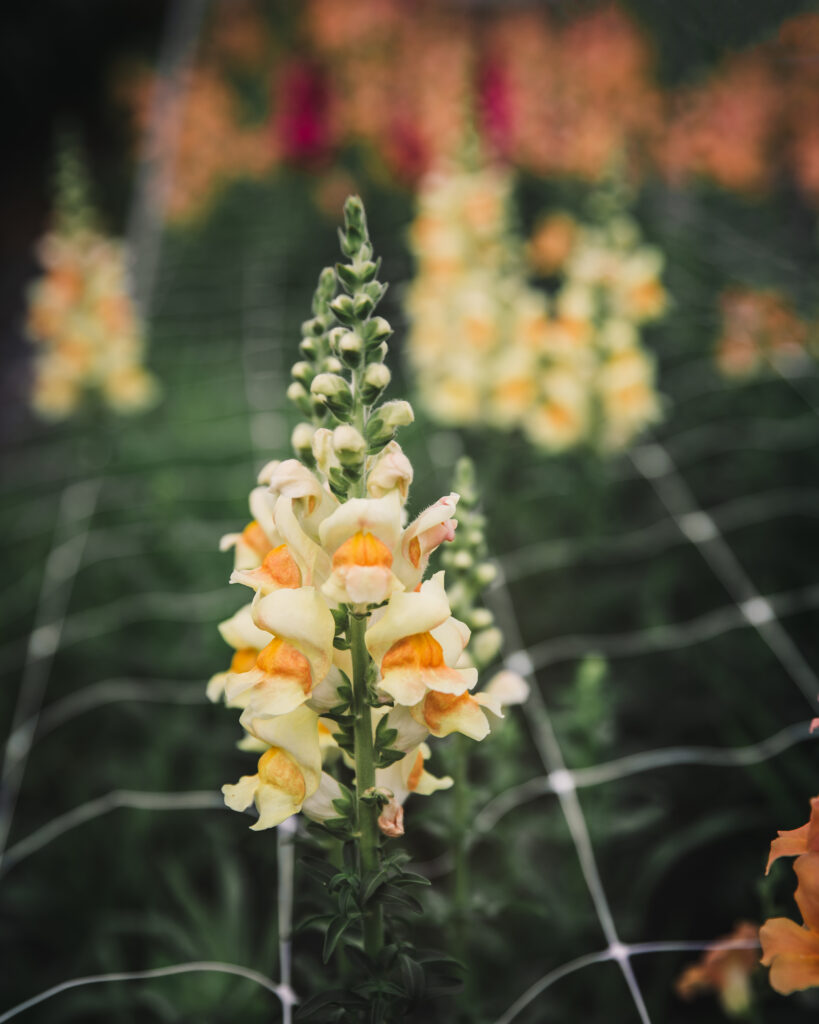
Transplanting, Spacing, Support: N&B
For best results, Johnny’s recommends hardening off plants by gradually exposing the seedlings to their outdoor environment 8–10 weeks after sowing, and transplanting when the plants are acclimated. When to transplant is highly dependent on location and environment. It’s possible to grow snapdragons year round in certain areas and in greenhouse production. Most sources recommend succession planting every three weeks for a continuous harvest.
Spacing depends on desired plant habitat. Most sources recommend spacing plants 6–12″ apart if pinching and 4″ apart if not pinching. Dowling and Farmer Bailey recommend placing 2-3 plants in each planting hole spaced 6″ apart (if not pinching).
Relevant findings from USU: A 9-inch spacing with pinched plants was most economical and had greater yield. Comparatively, a 4-inch spacing with non-pinched plants nearly doubled labor, seed, and supply cost, and produced fewer stems per square foot.
All sources recommend supporting plants with one or two layers of support netting.
Transplanting, Spacing, Support: BTS
Snaps definitely need to be hardened off, as those little babies can be quite sensitive. However, once they’re established, they can be quite tough! Previously, I’ve followed recommendations to space at 9″ and pinched most plants, my thought being to maximize yield. However, I have decided to move to the method of 2–3 plants per hole at 6″ spacing. This thought crossed my mind during the 2021 season, I realized that my pinched Chantilly’s had thinner, weaker stems. This might seem like, duh, but the thought hadn’t crossed my mind. I just assumed it was something you always pinched, like dahlias.
I first heard of 3 plants at 6-inch spacing from Sunny Meadows Farm, while taking their high tunnel course. Even if yield is less, I’m hoping this results in higher-quality blooms (and really, that’s a lot of plants in a small amount of space). We always use a layer of support netting, but might opt for two in the tunnel, because field snaps have fallen over and grew at a 90-degree angle because of the geotropic qualities. Still, snaps are so prolific, I usually find we have more-than enough.

Successions & Groups: N&B
Most sources recommend sowing and succession planting every three weeks for continuous harvest. As previously mentioned, snapdragon varieties are classified into numbered groups corresponding with the growing and harvest periods. USU notes they are grouped 1-4, according to their blooming response to light and temperature. Groups 1–2 bloom the earliest under less intense light and lower temperatures, while groups 3–4 bloom the latest under higher light and temperatures.
Dowling recommends Group 1 for winter and early spring, Group 2 for spring, Group 3 for late spring early summer, Group 4 for summer, and Group 3 again for fall. He states you would not want to plant a Group 1, like the Maryland series, for summer because they simply won’t bloom.
According to Johnny’s, “Plantings should be scheduled according to season, variety, and group to ensure maximum stem length and bloom quality for your climate and growing season.” They provide the following table of recommendations:
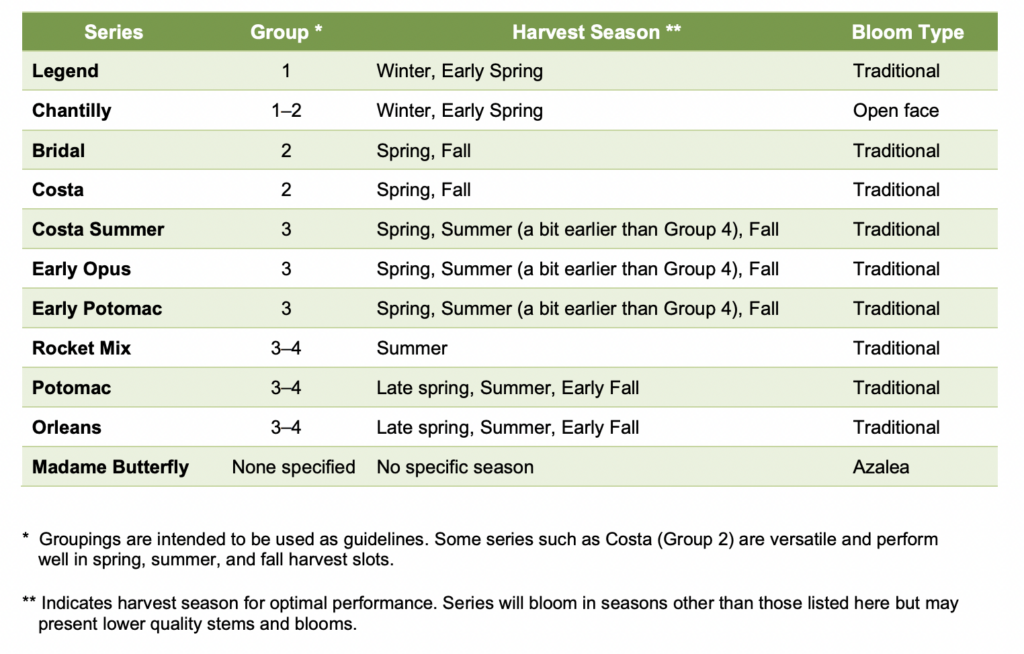

Most sources note that groups do tend overlap and that many varieties will bloom and produce usable stems outside of their assigned group but lower stem and flower quality will likely result.
USU trials in Zone 5 Utah found the following optimum planting dates:
High Tunnel
For greatest yield and extended harvest, optimal planting times were the first and last weeks of March in the high tunnel. February plantings are possible with group 1-2 cultivars (e.g. ‘Chantilly’), but group 3-4 should wait until March, when temperatures and light levels are higher. Planting after March is not recommended for any cultivar because marketability decreases. For example, March plantings produced 7-13 more marketable stems in 2018, and 13-17 more stems in 2019, compared to April plantings in high tunnels.
Field
Optimal planting times for the field were late-April to mid-May. Earlier field plantings may be possible with low tunnels, but were not included in this study. A late May planting can help extend the harvest window, but high temperatures will generally reduce yield and marketability.
A trial in Zone 8 found no significant differences in yield or stem length between ‘Potomac Red’ transplanted in early March vs. mid-April in a high tunnel (HortSience).
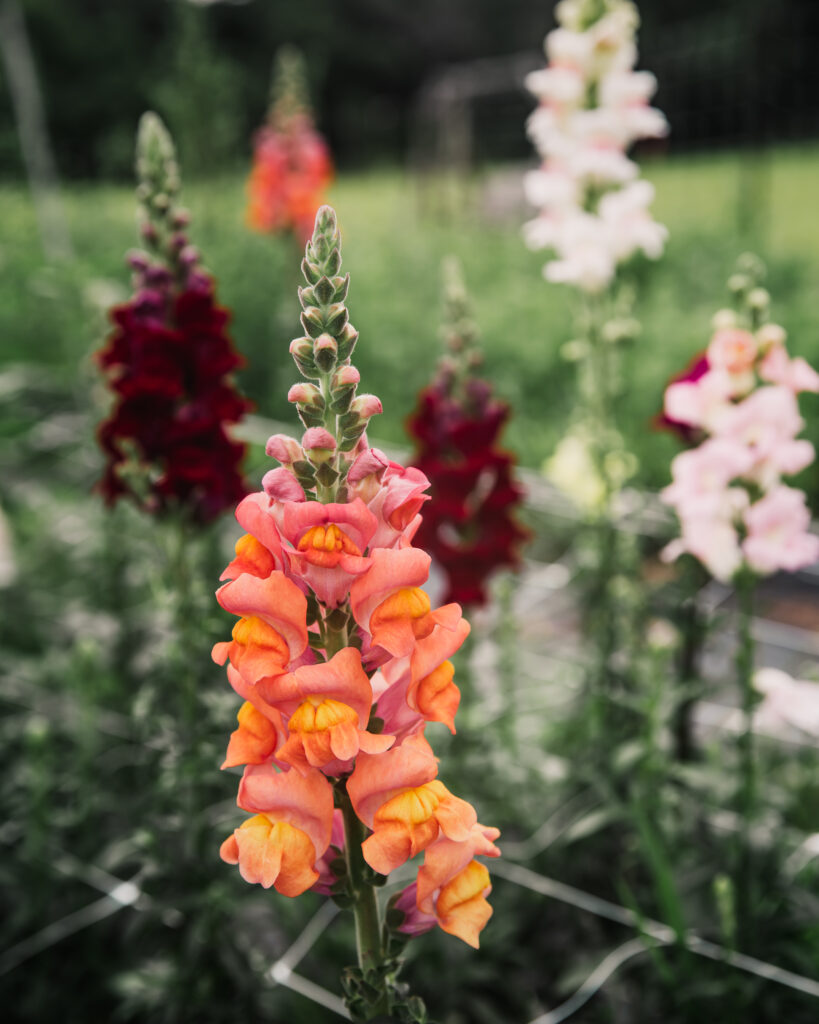
Successions & Groups: BTS
Thus far, I usually just start a variety of snaps from different groups during February and plant out in the field in late April or early May, and the groupings provide flowers usually from June to early August (historically: Costa Series, Chantilly, Madame Butterfly, Potomac). They definitely peter out in August though, and I am inspired to try and have snaps for a longer period (both earlier and later), because they really are so reliable.
Interestingly, Dowling noted that Maryland would not produce in summer, and even though our late spring and early summers can get quite hot, I did not have a problem with Maryland Rose. Call this blind luck, because I simply planted it because I liked the color and it was listed as a Group 1/2 and I’ve had good luck with the Costa Series (which are Group 2) in June/July, despite snaps being a “cool” flower and our weather getting quite hot (80s and 90sF not unusual).
While I had hoped to get a head start in the tunnel in March this year, due to work travel and crazy weather (and all of my frost blankets on the ranunculus), I chose to switch focus and plant a succession of lisianthus first, and had to hold off on the snaps until just recently. Although I love snaps and find them to be quite a reliable flower, sometimes farming when your time is limited means making tough choices as to where to focus your attention.
I may try for a succession sown indoors in the next few weeks, transplanted in the field late May for a fall crop (perhaps Opus Orange / Costa Apricot / Madame Butterfly Bronze and/or Red). Most excitingly, I want to do an overwinter trial based on Johnny’s findings. My plan is to sow in August, and transplant in October for an early spring harvest next season. It would be the cat’s meow to get some primo stems here in the midwest.
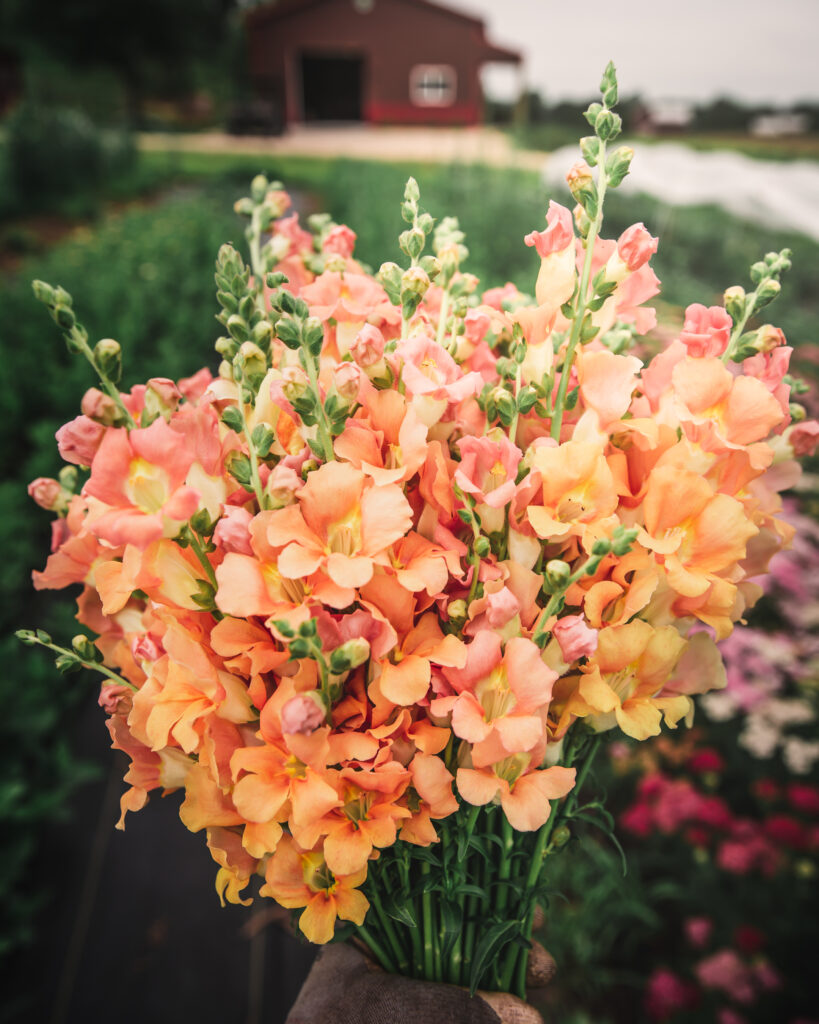
Nutrition: N&B
Snapdragons have moderate nutrient requirements. USU recommends 0.15 pounds of nitrogen should be added per 100 square feet each year. Phosphorous and potassium should be added before or at planting, but should only be applied based on a soil test, as these nutrients can build up in the soil. Dowling and SCF recommend a general fertilizer and that plants benefit from fertilization.
Nutrition: BTS
I am sure that dialing in your fertilization game per crop is ideal, but we do not do that. We fertilize our fields organically based on soil tests, and we do not fertilize for each crop individually (though I may toss a little extra Nitrogen on my N-loving sweet corn). I have an eBook that outlines exactly how we do this. I’ve made that available for you here.
Drainage & Irrigation: N&B
Most sources recommend drip irrigation. Overhead can be used, but it does increase the chances of disease. To prevent disease, water early in the day so that the foliage is dry by nightfall. According to USU, snapdragons need a consistent supply of water for maximum growth. They recommend applying 1 to 2 inches of water per week, depending on temperature, growth stage, and soil texture.
Drainage & Irrigation: BTS
At our farm, we have gossil-loamy sand, meaning that our soil is more sand than loam. It actually drains excessively to the point of leaching nutrients. Supplemental irrigation is a must on our farm, especially in dry spells. For this reason, we do have drip irrigation installed on all of our beds at the home farm.
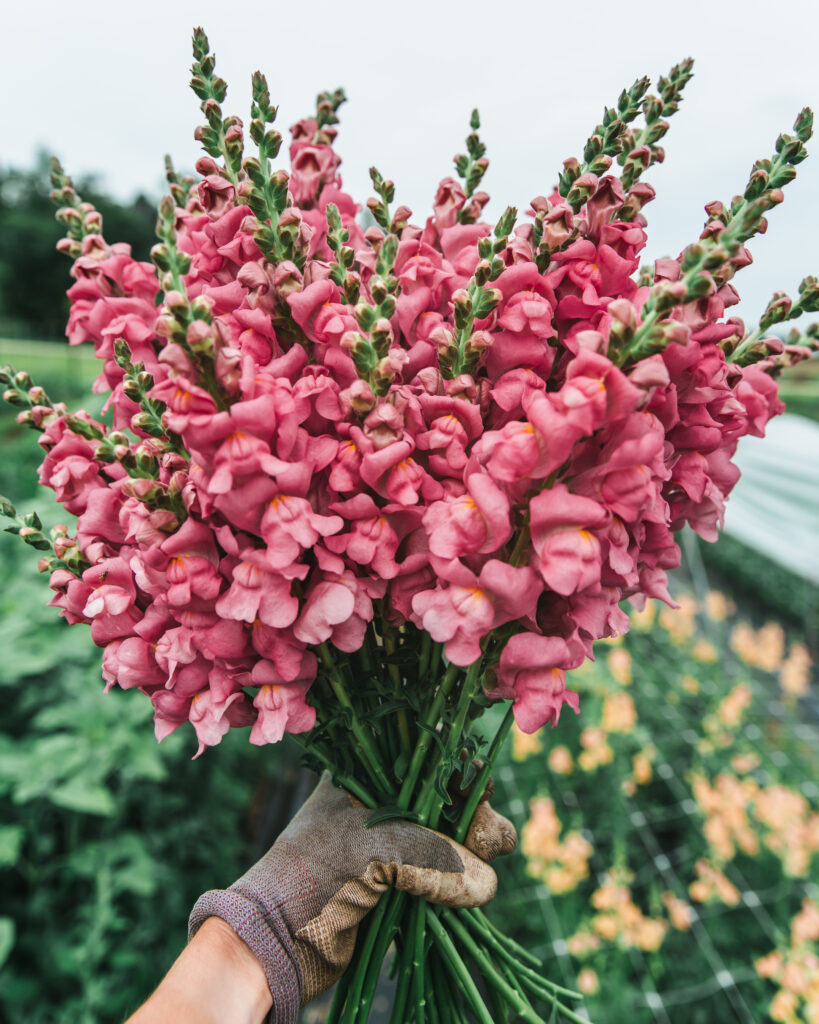
Pinching: N&B
USU notes that when plants have developed 5–6 nodes, they can be pinched back to 3–4 nodes to promote branching. Pinching can delay blooming, but produces 5–8 marketable stems in a season. Non-pinched plants bloom earlier, but produce a single stem per plant. The first stem can be harvested at 2-3 nodes for a second flush of stems approximately three weeks later. Similarly, Dowling notes that plants should not be pinched for more-marketable stems, but that pinching does increase yield. Bailey prefers not to pinch, resulting in taller stems with larger flowers. Johnny’s also notes that the single stem results in superior length and bloom quality.
Pinching: BTS
As noted earlier, I always pinched my snapdragons, but I plan on spacing closer together and not pinching this season. I’ll report back results.
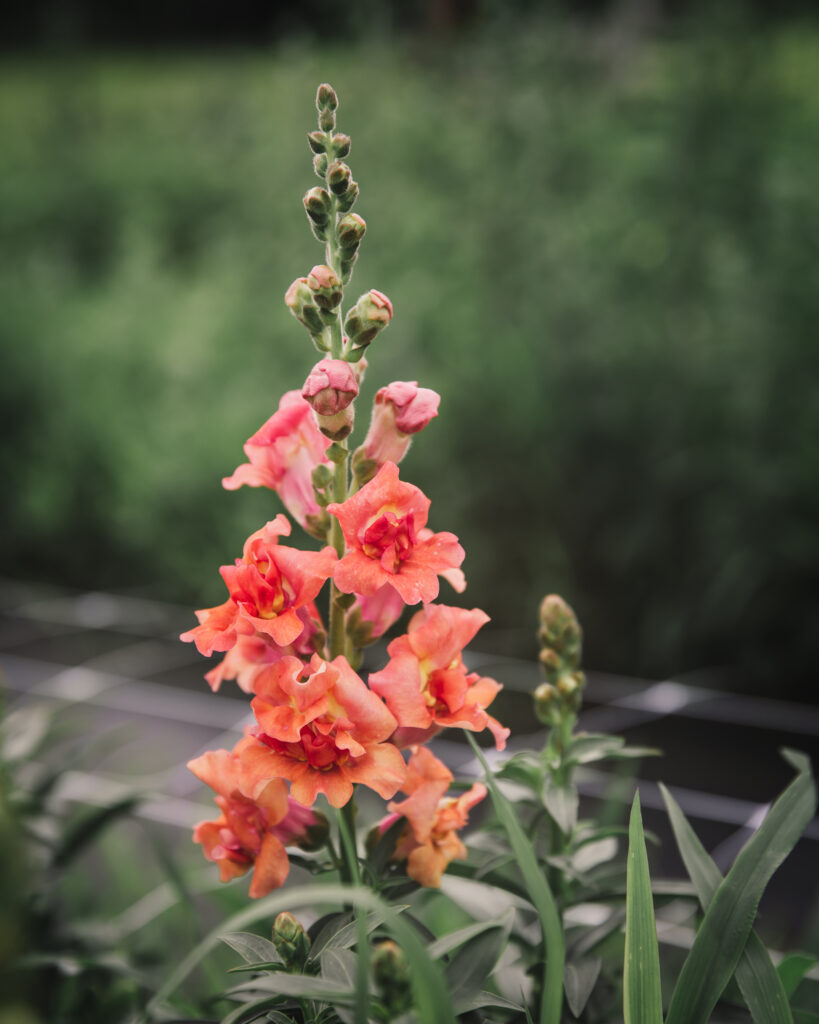
Bloom Period: N&B
Bloom period is highly dependent on geographic location, growing environment, and fall versus spring production. According to HortScience, selecting optimal transplant dates in the high tunnel and field based on cultivar bloom timing maximizes marketable yields and results in a harvest window lasting 4.5 months. They provide the following planting and bloom periods for zones 7, 5, and 3/4:
In a field trial in Tennessee (USDA-ARS, 2012; USDA Hardiness Zone 7a), ‘Rocket Bronze’, ‘Rocket Pink’, and ‘Rocket White’ (Group IV) were transplanted 5 May and began blooming in early June (Starman et al., 1995). The total yield averaged 16 to 30 stems per plant (112 to 210 stems/m2) and 36 to 45 cm stem lengths which (Starman et al., 1995). Some researchers have used a grading standard of 30 to 41 cm for marketable stems (Kluza, J. 2019; Ortiz, et al., 2012: Owen, et al., 2016; Starman, et al., 1995), whereas others have used 46 cm as the grading minimum for marketable stems according to the Society of American Florists (Carter and Grieve, 2008; Dole and Wilkins, 1999; Miller, 1961). In Indiana [USDA Hardiness Zone 5b; USDA Agricultural Research Service (ARS), 2012], ‘Rocket Red’ (Group IV) was planted on 16 and 17 May, 1 week after the last frost date; this yielded an average of 183 stems per m2 and 51.8 cm stem lengths in the high tunnel, and 158 stems per m2 and 39 cm in the field, indicating that high tunnels can significantly increase both production quantity and quality (Ortiz et al., 2012). In North Dakota (USDA Hardiness Zones 3b to 4a, USDA-ARS, 2012), a mix of ‘Rocket’ varieties and ‘Potomac White’ were planted 20 May through 10 June 2016 and 24 April through 2 June 2017 (Kluza, 2019), up to 7 weeks before the last frost date (North Dakota State University, 2016).
In Zone 7/8, Ziegler recommends planting hardy annuals 6 to 8 weeks before first frost for overwintering, noting that her first snapdragon harvest is in April.
For Johnny’s overwinter trial in Zone 5a Maine, they sowed snapdragons on August 15, transplanted to the high tunnel October 14, and had their first harvest May 19.
Bloom Period: BTS
As mentioned earlier, historically we’ve sown snaps in February from number of cultivars and groups, plant out late April or early May (weather dependent) we have snaps from June to early August.
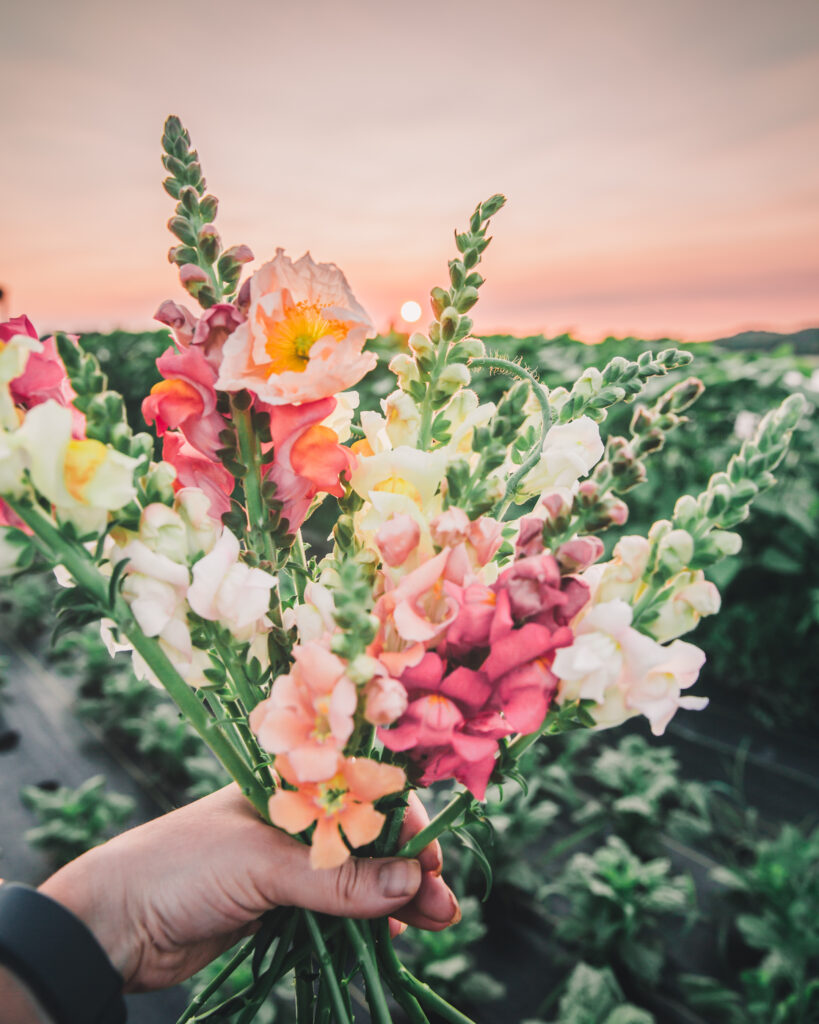
Additional Flushes: N&B
According to USU, allowing second flushes considerably adds to marketable yield:
When high tunnel marketability declined due to high temperatures in late July, plants were cut to a height of 3-5 nodes per stem and allowed to regrow in the cooler fall conditions. The second flush in the high tunnel occurred in late August to early September and increased total marketable yields for the season by 30–66%, depending on cultivar. ‘Chantilly’ and ‘Madame Butterfly’ were most productive in the second flush, as their groups (1-3) bloom under cooler temperatures and lower light.
While the second flush had less-marketable stems, it did extend harvest by 2 months with less labor and cost of a new planting (though potential yields of a second planting, whether snaps or another crop should be considered).
Additional Flushes: BTS
Because we have the space, I just let the beds go for as long as they will produce, but they usually peter out in August.
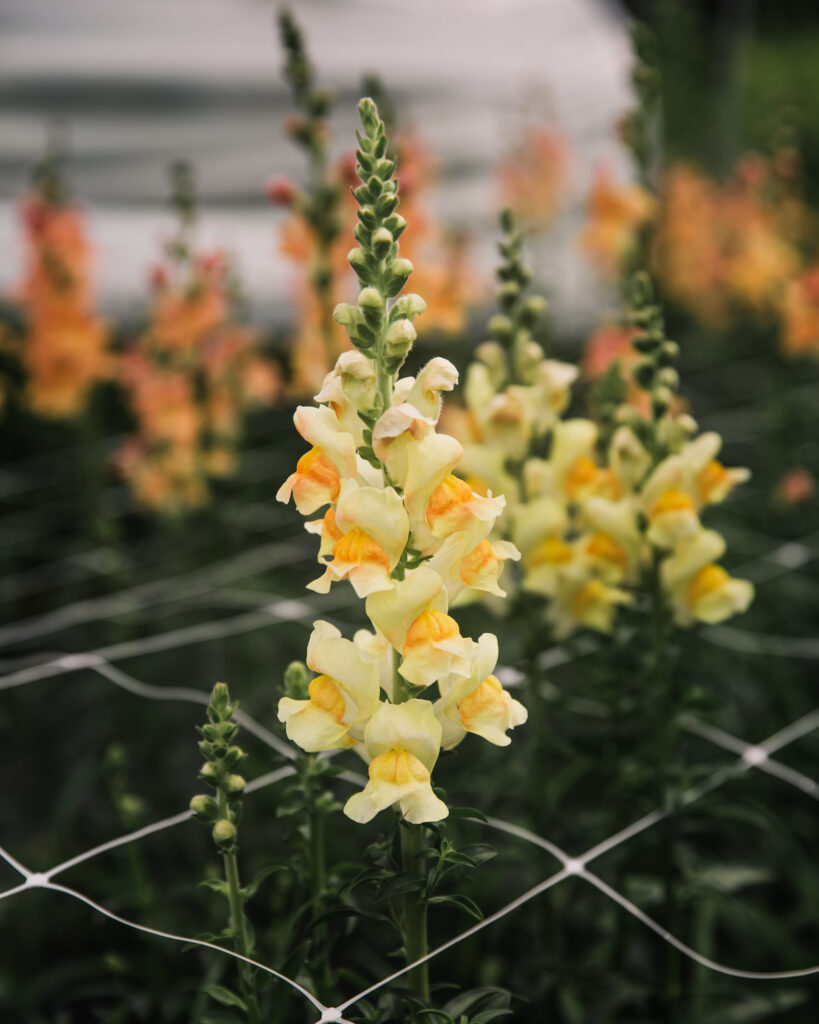
Overwintering: N&B
According to SCF, Zones 7–10 may overwinter in the field in areas where winters are sufficiently cold for flower production, but not so cold as to damage or destroy the plants. Similarly, Dowling notes that Zones 7 and warmer may be able to overwinter, with Zone 6 being able to overwinter with protection like a greenhouse or tunnel. Interestingly, overwinter trials at Johnny’s Selected Seeds in Zone 5a suggest we may be able to push this. In fact, their high-tunnel overwintered snapdragons had 100% survival rate (sowed on August 15, transplanted to the high tunnel October 14, and first harvest May 19). This is super exciting for those of us in colder zones!
Overwintering: BTS
As previously mentioned, I plan to do my own overwinter trial this fall for the 2024 season. I’ll likely stick with: Legend Series, Chantilly Series, Costa Series, and Bridal Pink.
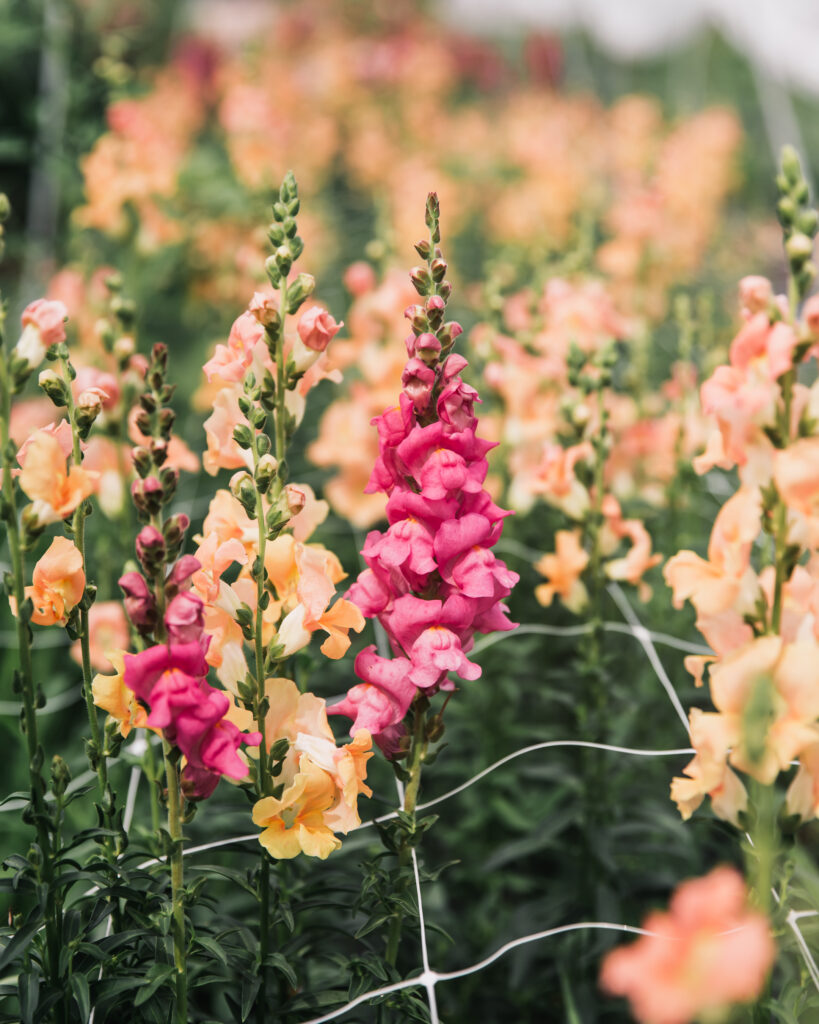
Harvest: N&B
Most sources recommend harvesting when 1/3 to 1/2 of the flowers are open and cutting into a holding solution. Postharvest Handling notes that if stems need to be stored, cut early when only 2 to 3 lower buds are expanding or showing color. In NC State trials, snapdragon stems harvested with just lower buds expanding had longer vase life than stems harvested with open flowers, but stems were not as showy. While Dowling had similar recommendations, he does note that snapdragons are ethylene sensitive, so it is actually better to wait to cut when the flowers are a little more open versus storing for a few more days. He states that the length of time they are on the stem doesn’t have much of an impact on vase life. However, he also notes that you have to beat the bees and that if they pollinate, those petals will drop (so you may want to harvest earlier).
According to Postharvest Handling, fresh stems last for 7 to 10 days in water and 12 to 15 days in preservative.
Harvest: BTS
We harvest exactly as recommended above 1/3 to 1/2 flowers open, though I will harvest them a little more open as necessary.
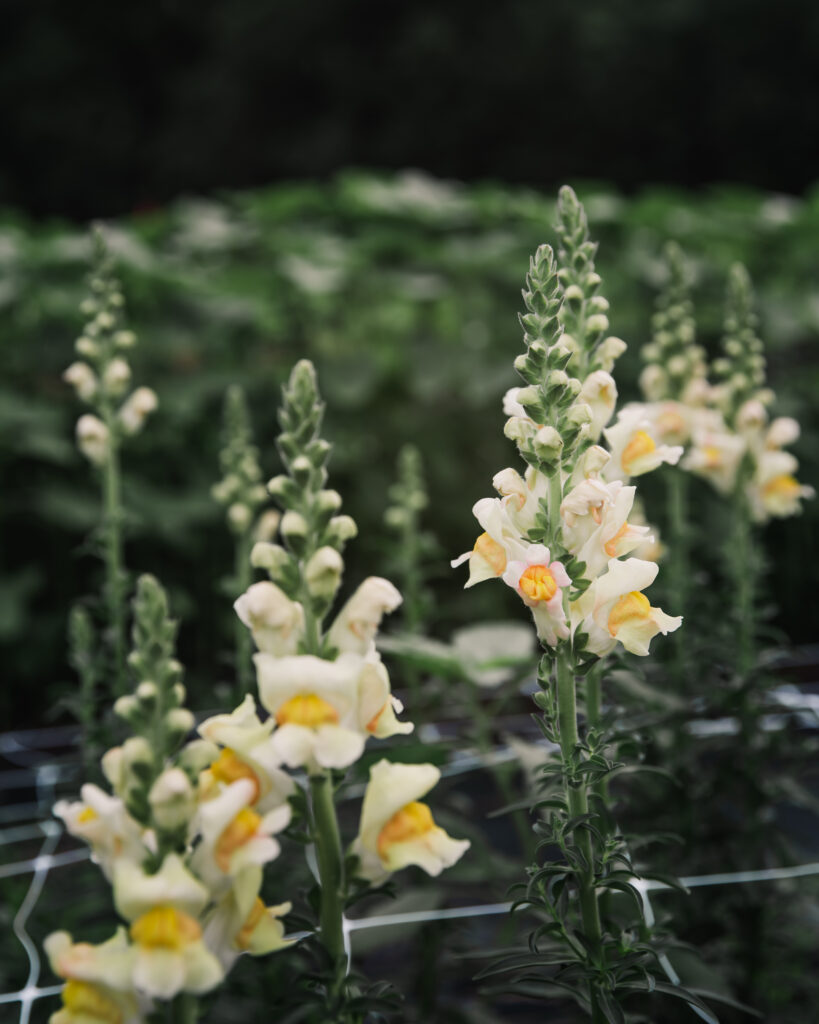
Post-Harvest Treatment and Storage: N&B
Most sources recommend harvesting into a holding solution. All sources note that snaps should be stored upright because they are geotropic, meaning they have a growth response to gravity. In other words, if they are harvested and splayed in a bucket, they will grow upward causing curvature in the spike. Once this curve is set, it cannot be fixed. Dowling and Ziegler recommend harvesting into a tall bucket and packing them in to keep them upright/vertical (like a 5-gallon bucket).
Postharvest Handling notes that stems may be stored dry or wet at 40F (4C) for 5–7 days. In NC State trials, snaps stored dry had a longer vase life than those stored in water. They then note that stems can be stored for 10 to 14 days at 38–40F (3–4C). If stored dry, they recommend rehydrating in a bud-opening solution at 70F (21C) with >80% relative humidity at 16h of daylength.
Post-Harvest Treatment and Storage: BTS
We harvest our snaps into holding solution and store in the cooler around 38F. I’ve never stored them dry but NC State trials are intriguing. To keep plants upright, I will use a larger bucket, but sometimes they are not around. If not, I will lean the snaps up agains the wall on the cooler to make sure they stay upright.
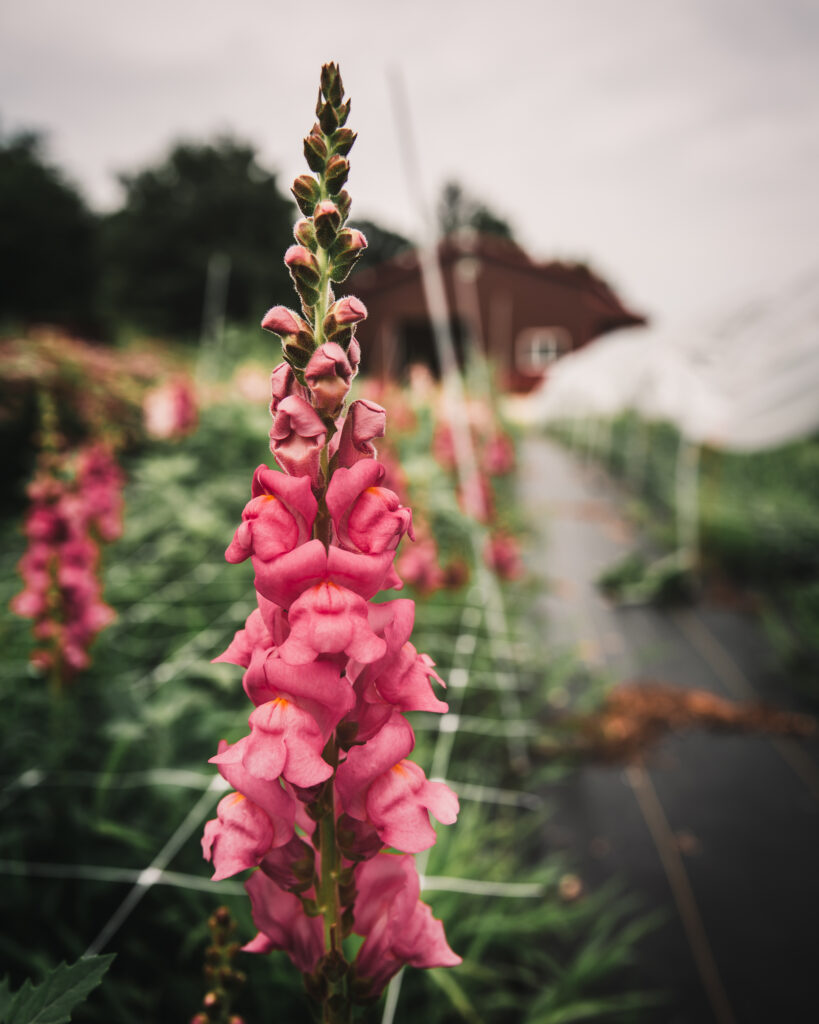
Pests & Disease: N&B
According to SCF and Johnny’s, the most prominent and serious disease in snapdragons is rust. Caused by the species-specific fungal pathogen Puccinia antirrhini, Johnny’s suggests that rust can be identified by a buildup of dark-brown to purple spores on the stems and leaves. However, they do note that the most accurate way of identifying disease is to send a sample to your local Cooperative Extension service or other agricultural research station.
Snapdragons are also susceptible to botrytis, powdery and downy mildews. The most common pests of snapdragons are aphids and thrips. Crop rotation should be practiced to prevent the build-up of pathogens and pests in the soil (Johnny’s).
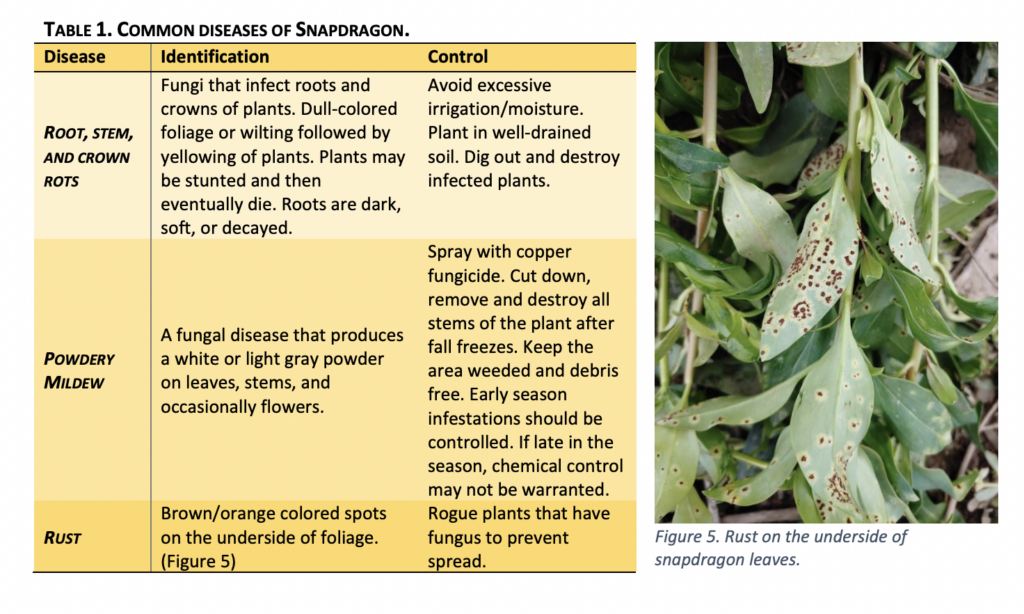
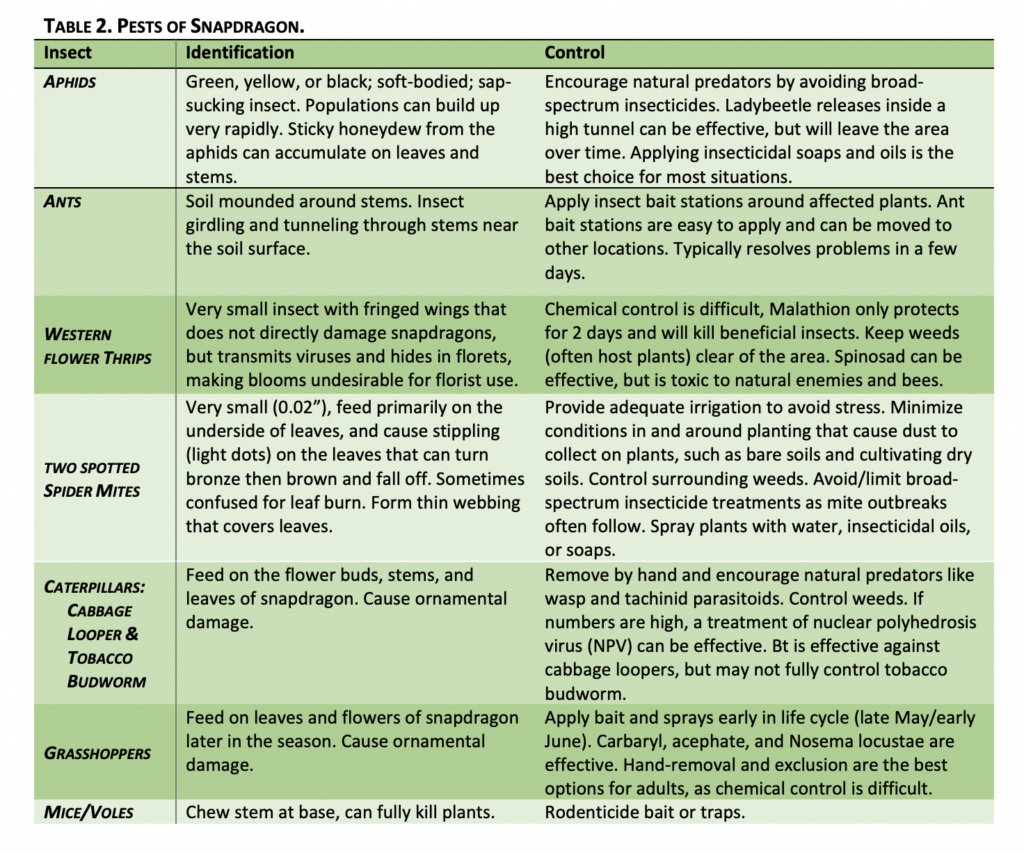
Pests & Disease: BTS
We rarely have any pest or disease issues with snaps, maybe the occasional thrips, and if so, I’d just toss the affected stem. We always practice crop rotation with all of our crops, as we as introduce beneficial insects like ladybugs and lacewings.
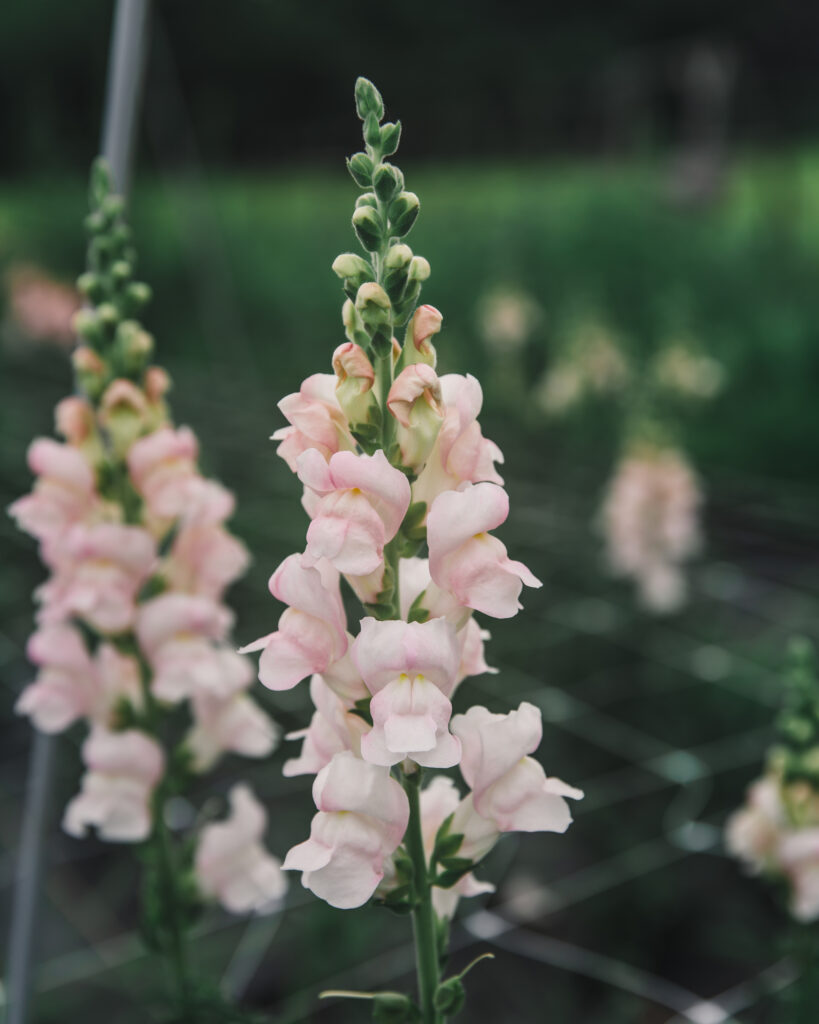
Variety Selection: N&B
Most sources seem to recommend many of the same series: Costa, Chantilly, Butterfly, Potomac, Rocket, Opus, with Dowling and SCF also mentioning Maryland and Johnny’s noting Bridal Pink and Legend Light Pink as performing well in their overwinter trial for early spring snaps.
Variety Selection: BTS
Varieties I’ve Grown
Costa Silver, Costa Apricot, Chantilly Salmon, Chantilly Light Pink, Madame Butterfly Bronze, Potomac Mix
What I’ve Dropped
Chantilly Light Pink, I like it, but I have plenty of pink, prefer Chantilly Salmon, and needed more whites for event work. Potomac Mix, I love Potomacs, but opted for specific colors and the new mixes from Johnny’s this season.
What I’m Growing This Season
Legend Light Pink, Bridal Pink, Costa Silver, Chantilly White, Chantilly Salmon, Orleans Light Yellow, Potomac Yellow, Potomac Lavender, Potomac Sunrise Mix, Potomac Berry Mix, and I may sow Costa Apricot, Madame Butterfly Bronze, Madame Butterfly Red, and/or Opus Orange for fall.

Pricing: N&B
BOSTON Ornamental Terminal Prices as of 11-APR-2023:
SNAPDRAGON: MARKET STEADY. bunched 10s CD long 15.00-18.50 mostly 15.00 med
12.50-13.50 mostly 13.50 NENG long 18.00
Typically in wholesale markets, snapdragons are graded and priced accordingly. Interestingly, HortScience reports different findings locally:
…local markets did not support price variation by marketable grade. Regardless of marketable stem length, bunches of five consistently sold for $7.50, the equivalent of the maximum wholesale price for long to extralong stems (USDA Agricultural Marketing Service, 2019), indicating a strong and consistent market demand for local production and more relaxed standards for quality based on stem length. However, sellers and florists also showed preference for stem lengths between 60 and 76 cm, which were less prone to breakage during storage, transport, and floral arranging, and stems that were stored upright to prevent curvature. Therefore, continued, local production of stems that are 60 cm or longer, which can be trimmed to the marketable length and are minimally curved, can supply a niche market in high demand.
According to USU, “Snapdragons are a florist staple and are consistently in demand due to their tall upright blossoms, long vase life, and strong stems. Wholesale snapdragons are easily damaged during shipping and storage. Therefore, high-quality, locally grown snapdragons that are longer than 18 inches and a popular color are in strong demand. The wholesale price for snapdragons ranges from $1.20-$1.30 per stem. USU trial snapdragons in bunches of 5 sold for $6.00 ($1.20 per stem) in the Cache Valley and Wasatch Front markets.”
Pricing: BTS
In 2021, my price to florist for snaps was $12 / 10 stems (another local grower in my area was at $11.50). You might be wondering: what about 2022? We didn’t grow snaps in 2022, oy, I know, I was so sad! Our high tunnel construction took much longer than expected and my snap trays got sad (and then all bit down to the soil line by a squirrel, UGH!). Every time I’d get a request for snaps, I’d cry a little inside lol. I was sure to sow extra trays this year. Depending on quality, I’ll likely come in at 13.50 to 15 for 2023.
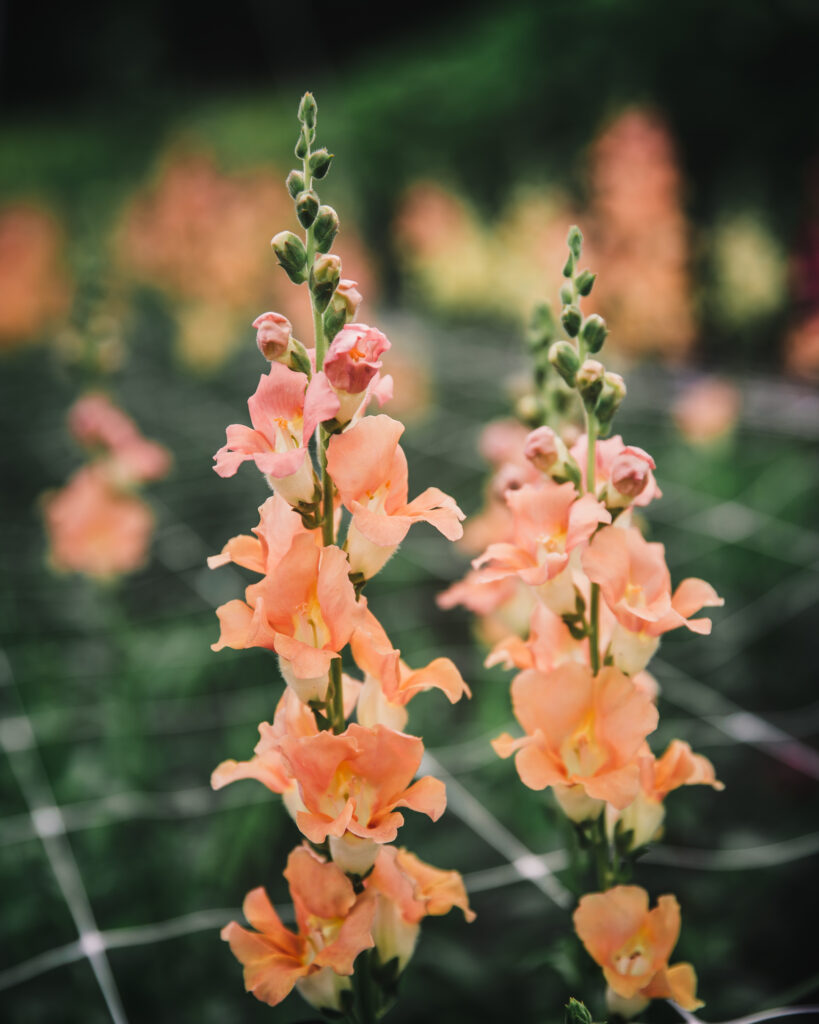
Wrap Up
OK, my friend, that is IT for April’s Plant Profile. What do you think? Did you find some useful nuggets? Is there anything that’s unclear or you wish I would have covered? Or is your head spinning? No worries, you will get a copy of this before May goes live, so you can always refer back it. Tip: use the find shortcut (Ctrl+F on a PC or Command+F on a Mac to search for any word or term).
Have any questions or something you want to share with me or others? I know I say this ad nauseam, but I truly believe in the power of the collective and that we all have something unique and powerful to share, so please leave a question or share a comment below. We’re all better for it, and I thank you in advance!
Cheers pal!
cLICK FOR Comments +